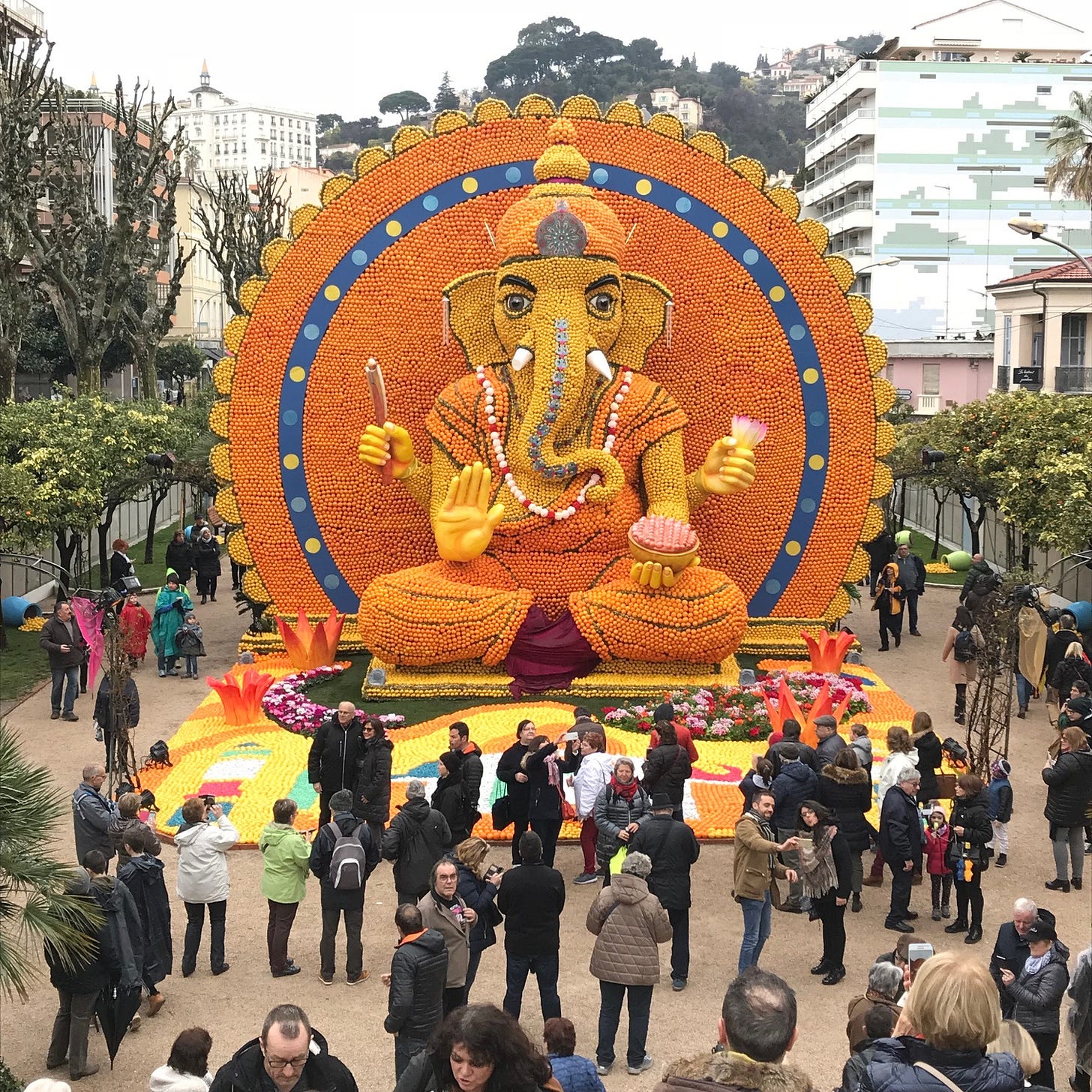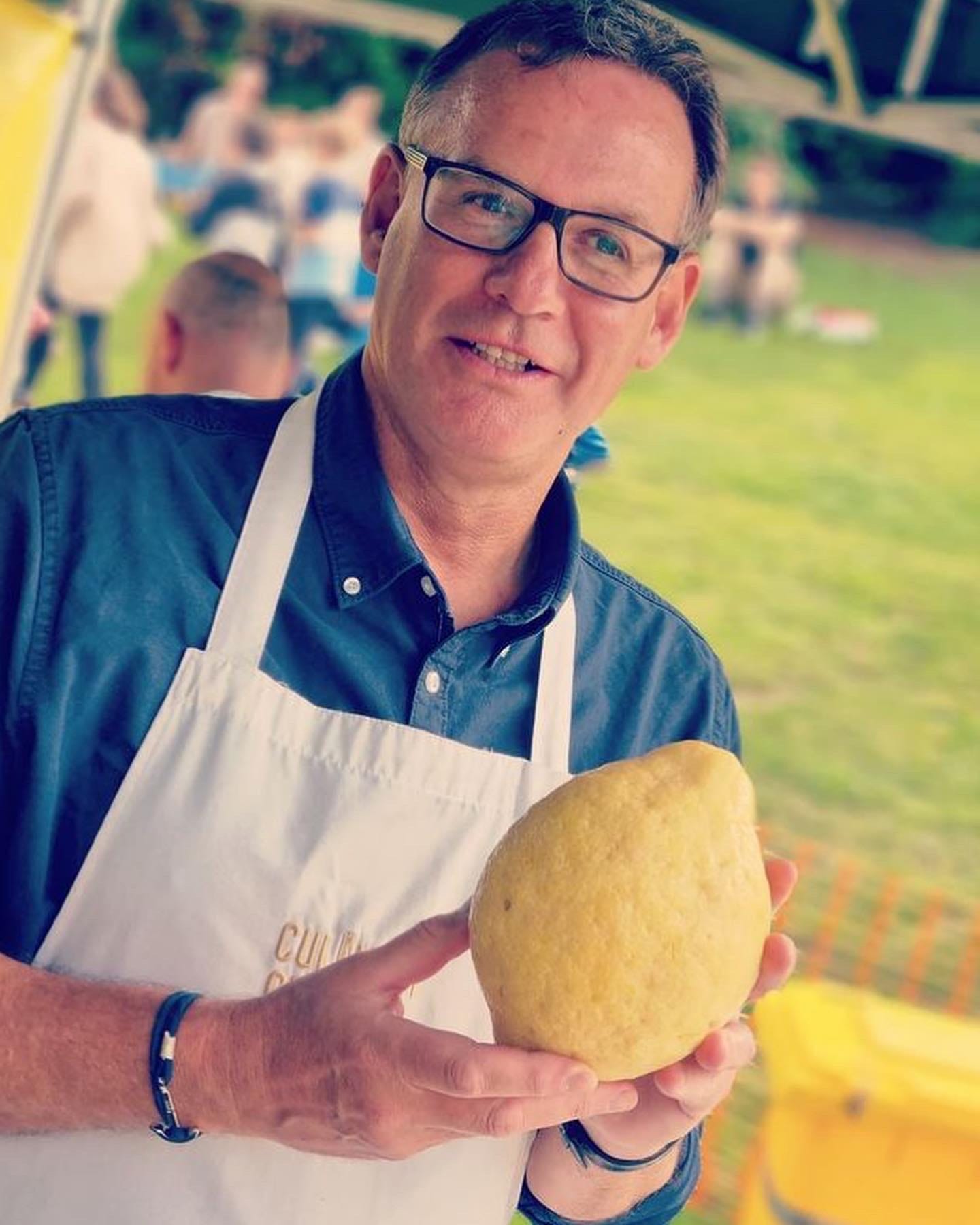In this issue:
Pod News
Oranges in Majorca
Theme released for Menton’s Fete du Citron 2023
Vintage cookbooks released online
River Cafe’s latest cookbook
Recipe: Monkfish with pancetta and lemon
POD NEWS
Links for ‘In this issue’
Five minute listen
Stanley Tucci’s Searching for Italy. Search BBC & CNN.
UNISG+ Free course in Italian food history. Click here for more.
Boris Johnson eating a LemonTop ice cream. Click here.
LemonTop Gin. Click here.
Lemons take the breeze in the Balearics
Majorca, written Mallorca in Catalan, is the largest island in the Balearic islands and has a generous sprinkling of fragrant citrus groves full of orange and lemon trees. The island is a popular holiday spot where tourists slake their thirst with juicy oranges and unwind in a deliciously comfortable climate and beautiful views everywhere.
Lying on the northeast coast of Spain, the island's citrus industry is based around Sóller, a traditional seaside town on the Mediterranean island's remote, craggy west coast. It's at the centre of the island's Golden Valley, a region bursting with voluptuous oranges and lemons. During Autumn, the island hosts fairs and festivals dedicated to such products as olives, mushrooms, pumpkins, wine, sobrassada (a raw, cured and spicy meat paste sausage made with paprika) and honey.
Mallorcan farmers also produce a suckling pig known as porcella; about 15,000 tonnes of sea salt from Salines de Colonia Saint Jordi, on the island's southeast corner; olive oil and cheeses. The island is also famous for Angel d'Or, an orange liqueur. A naturally fruity and slightly bitter-tasting liqueur enjoyed straight, on-ice splashed into various cocktail varieties. For example, the refreshing Fresquito (fresh juice on ice), the sparkling 'Angel d'Or con Cava' (with sparkling wine) or even the exotic "Caipirinha d'Or" (with lime and brown sugar). Other local liquors are made with almonds and dried herbs.
London-based chef Yotam Ottolenghi offers several great dishes using Mallorcan produce, including Caramelised Fig, Orange and Goat's Cheese Salad; and Apricot and Almond Ensaimada – a delicious pastry made with pork lard and grated orange zest.
Other local cuisine includes such dishes as 'sopa de nadal', a traditional Christmas chicken broth made with foie gras and pasta; 'Porcella amb anfòs', a stuffed suckling pig with roasted onion and apple puree, and 'Ensaimada de torro', a speciality almond filled sweet bread.
In late May/ early June, Sóller hosts the Fira Taronja, a festival dedicated to the orange. The event takes centre stage in street celebrations, and many restaurants offer citrus-themed menus. Hotels and B&Bs get in on the action as well. So, if you want to stay amongst the orange groves and taste the local produce, try Finca Ca's Sant. They offer hyper-local food with homegrown/made marmalade served at breakfast on elegantly laid tables under citrus trees and an estate dating back over 600 years.
Citrus harvest
Navelina oranges are harvested from November through early January and are characterised by a strong acidity and medium sugar content. A close relative to the Navelina is the Navel which is harvested during January and February. This is a busy time for picking, with the popular varieties being Navel oranges grown across the island. The Canoneta variety, which overflow with juice, are more often squeezed for drinking. Bitter oranges (a cross between grapefruit and tangerines) are available until the end of February and make delicious bitter orange marmalade. Lemons and grapefruits are also grown on Mallorca.
The less common, delicately skinned Ortanique has a well-balanced relationship between sweetness and acidity, making them ideal for cutting in quarters for slipping into the expectant mouth. The Valencia Late is another delicious orange for eating or juicing. It crops in May and July. And finally, the pear-shaped, greenish with yellow appearance Peret is delicious to eat and makes a spectacular juice in the summer.
Click here for more information about travelling to Mallorca and her sister Balearic islands of Menorca, Ibiza and Formentera.
Rock & Opera for Menton lemon festival 2023
February 11 – 26, 2023
Lemon fever affects the beautiful French seaside town of Menton every February. Local mythology says that when Adam and Eve were banished from the Garden of Eden, Eve smuggled out a lemon, burying it in fields that would become Menton. Organisers of Menton's annual Fête du Citron have chosen Rock & Opera as the theme for the whimsical festival that pulls in more than 200,000 visitors every year. Menton has a unique micro-climate due to its location on the France/ Italy border between the Mediterranean Sea and Alpes Maritime. Growers tend to dozens of fruit varieties, from kumquats to grapefruit. However, it's the three lemon varietals: Santa Theresa, Villafranca, and Eureka, that attract visitors.
I'm lucky enough to have been three times and love visiting the Cote d'Azur for a few days in February. Flying out from under gloomy Britain skies to land in Nice and a magical train ride along the coast through Monte Carlo is just the boost I need at this time of year (note: a tunnel whisks you under Monte Carlo, so you miss that particular view)
The festival runs for 15 days and includes day and night-time parades to admire the Exhibition of citrus patterns in the town centre gardens, a crafts fair, and a Festival of Orchids. Hundreds of volunteers used tonnes of lemons and oranges attached with rubber bands to giant chicken wire sculptures to create a surreal atmosphere of creativity in a perfumed citrussy breeze.
More to follow, but in the meantime, click here for the festival website. Book early for the parades and accommodation.

Thousands of vintage cookbooks online
Around 10,000 antique and vintage cookbooks have been digitised and are freely available through The Internet Archive's Cookbook & Home Economics Collection.
As you can imagine, few topics are left out of this extraordinary archive. The subjects are popular, rare and eclectic, from the fictional 1950s lifestyle and baking celebrity Betty Crocker collections to 'Cooking and Dining in Imperial Rome' published in the fourth century.
After a quick browse, I came across this little gem. It comes from De re culinaria aka De re coquinaria, a collection of fifth-century Roman cookery recipes credited to the Roman gastronome Apicius:
ROSÉ WINE WITHOUT ROSES; Rosatum sine rosa
'Rosé wine without roses is made in this fashion: a palm leaf basket full of fresh citrus leaves is immersed in the vat of new wine before fermentation has set in. After forty days retire the leaves, and, as occasion arises, sweeten the wine with honey, and pass it up for rose wine.'
Spend hours of fun searching the catalogue here.
The River Café Look Book, Recipes for Kids of all Ages
The first children's cookbook from London's iconic and world-renowned River Cafe has been published. The collection includes more than 50 classic River Cafe recipes reworked for new and young cooks.
This highly anticipated, child-friendly cookbook comes direct from the kitchen of the iconic and beloved Michelin-star restaurant River Cafe on the banks of the Thames in London. Its recipes bring the warmth, beauty, and apparent ease of Italian family home cooking to kids of all levels of kitchen expertise. The book introduces inventive garden-fresh meals such as Smashed Broad Bean Bruschetta, Fusilli Zucchini, Grilled Peaches and classics such as Carbonara and Focaccia.
The vivid and playful pages of the book showcase garden-fresh meals such as Smashed Broad Bean Bruschetta, Fusilli Zucchini, and Raspberry Sorbet, along with new versions of River Cafe classics, including a lemon tart, a luxurious chocolate torte, and tasty pesto.
The book is co-written by the restaurant's co-founder, Chef and cookbook author Ruth Rogers and her joint head chefs, Sian Wyn Owen and Joseph Trivelli. Rogers launched River Cafe in London alongside Rose Gray in 198 and has since trained many superstar chefs in its kitchens and won multiple awards, including a Michelin star. Indeed, a youthful Jamie Oliver was first captured on screen on a TV show about the restaurant.
Co-head chefs Sian Wyn Owen and Joseph Trivelli have both worked at London's River Cafe for over 20 years. British photographer Matthew Donaldson took the photos intended to spur cooks' imagination and creativity. As the authors put it, "cooking is more than just science, rigorous and measured."
Buy 'The River Café Look Book' here.
Monkfish & Pancetta with Lemon
This recipe is courtesy of the book's publisher, Phaidon.
Gather 4 (160g/5 3⁄4-oz) portions monkfish tail, deboned (boned) and skinned; sea salt and freshly ground black pepper; 16 thin slices of pancetta; a sprig of rosemary, leaves picked; three tablespoons extra-virgin olive oil; and two lemons, cut into wedges.
Preheat the oven to 200°C/Gas Mark 6 (400°F). Season the monkfish portions with salt and pepper.
On a sheet of baking (parchment) paper, lay four pieces of pancetta, slightly overlapping, to create a rectangle covering the monkfish portion.
Lay the monkfish portion on top of the pancetta and use the baking paper to wrap the pancetta around the fish.
Remove the paper. Tuck a few rosemary leaves into the pancetta. Repeat for the other three pieces of monkfish.
Heat the olive oil in a large ovenproof frying pan. Add the wrapped monkfish, seam side up.
Sear for 1 minute over a high heat, then turn over with tongs.
Put the pan in the oven and roast for 10 minutes.
When cooked, the flesh of the fish should be white throughout. Carefully remove from the oven and serve each portion with juices from the pan spooned over.
If you enjoyed this post, please click on the little ❤️ below ⬇️.
Bruce McMichael
Writer, Podcaster, Educator
Website: www.thelemongrove.net
Twitter: @lemonbites
Facebook: @lemongrovesocial
Instagram: @lemongrovepics
Disclosure: I am an affiliate of Bookshop.org
Thanks for subscribing to The Lemon Grove. This post is public, so feel free to share it.






